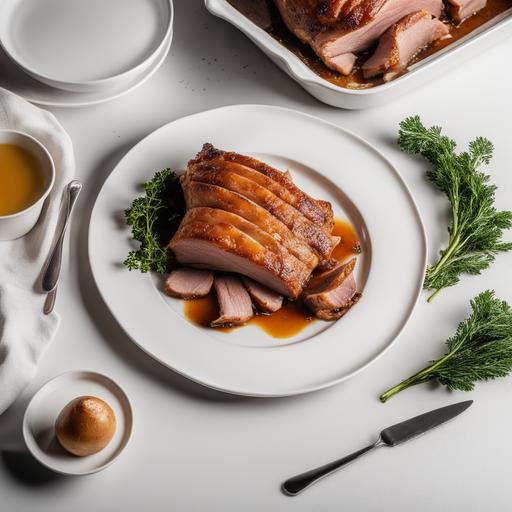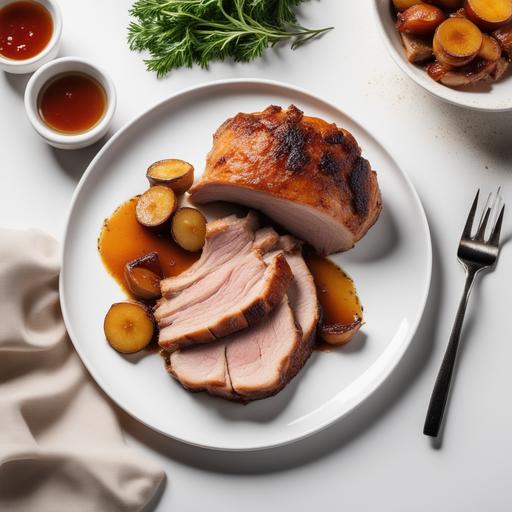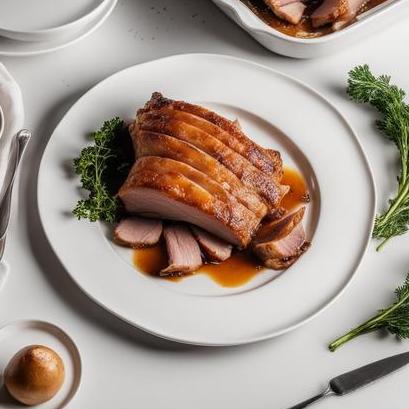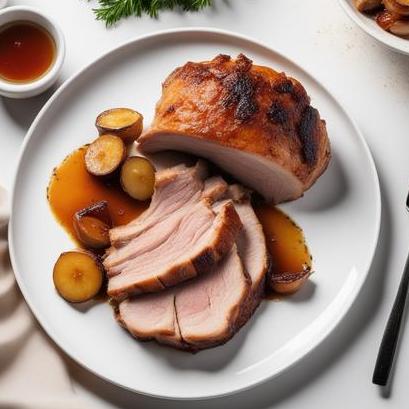
Roast Pork Oven Recipe: A Comprehensive Guide
When it comes to cooking meat, roast pork is a classic and delicious dish that everyone loves. With the right recipe and some tips and tricks, you can make a roast pork that is juicy, tender, and bursting with flavor. In this article, we will guide you through the science of cooking roast pork, culinary details, selection, cleaning, preparation, tips, variations, doneness checks, recipe, overcook, undercook, and everything else you need to know to make a perfect roast pork.
The Science of Roast Pork
To understand how to cook a perfect roast pork, it is important to understand the science behind it. Pork is a meat that has a lot of moisture and fat, which makes it juicy and tender when cooked correctly. However, it is also a meat that can easily become dry and tough if overcooked. Therefore, it is important to cook it slowly and at a low temperature so that the meat can retain its moisture and become tender.
The ideal temperature for cooking roast pork is between 325°F and 375°F. At this temperature, the heat will cook the meat slowly and evenly, allowing the fat to render and the meat to become tender without drying out. Cooking the meat at a higher temperature will cause the meat to cook too quickly on the outside, while the inside remains undercooked, which is not ideal.
Selection and Cleaning
Before we dive into the recipe and preparation process, it is important to select the right cut of pork for roast pork. You want to look for a cut that is well-marbled with fat and has a bone-in. The fat will melt into the meat as it cooks, adding moisture and flavor, while the bone will help to distribute the heat evenly throughout the meat.
When you bring the pork home, you should clean it properly. Rinse the pork under cold running water and pat it dry with paper towels. Remove any excess fat and silver skin, which is the thin layer of connective tissue that is found on the surface of the meat.
Preparation and Tips

Now that you have selected and cleaned your pork, it is time to prepare it for cooking. Here are some tips and advice on how to prepare and cook your roast pork:
-
Season it well – To make your roast pork extra flavorful, you should season it generously with salt, pepper, and any other herbs or spices that you prefer. You can also add garlic, rosemary, and thyme to the seasoning mix for a classic pork flavor.
-
Let it come to room temperature – Before cooking, let the pork sit at room temperature for 30 minutes to an hour. This will allow the meat to cook evenly and prevent it from overcooking on the outside while remaining undercooked in the center.
-
Use a roasting pan – To ensure even cooking, use a roasting pan with a rack. This will allow the heat to circulate around the meat and cook it evenly.
-
Baste it – To keep the pork moist, baste it with its own juices or a mixture of melted butter and wine or broth. Basting the pork will also add flavor and give it a beautiful golden-brown color.
-
Let it rest – After the pork has finished cooking, let it rest for at least 10 to 15 minutes before slicing it. This will allow the juices to redistribute and the meat to become tender.
Variations and Doneness Checks

There are many different ways to prepare roast pork, and the recipe can be tweaked to suit your preferences. Here are some variations you can try:
-
Stuffing – You can stuff the pork with bread, herbs, and spices for extra flavor. To do so, cut a deep pocket into the center of the meat and stuff it with your favorite ingredients.
-
Glazing – Add some sweetness and shine to your roast pork by brushing it with a glaze made up of honey, brown sugar, and mustard. This will create a crispy, caramelized crust and a deliciously sweet flavor.
-
Rub – Instead of seasoning the pork with salt and pepper, try rubbing it with a mixture of spices like paprika, cumin, and chili powder.
To check the doneness of the pork, insert a meat thermometer into the thickest part of the meat. The internal temperature should read 145°F. If the temperature is lower, keep cooking until it reaches the desired temperature.
Recipe

Here is a simple and delicious roast pork recipe that you can try at home:
Ingredients:
-
1 bone-in pork roast, about 5 pounds
-
5 garlic cloves, minced
-
2 teaspoons kosher salt
-
1 teaspoon black pepper
-
2 teaspoons dried rosemary
-
2 teaspoons dried thyme
-
1 tablespoon olive oil
Directions:
-
Preheat your oven to 350°F.
-
In a small bowl, mix together the garlic, salt, pepper, rosemary, thyme, and olive oil.
-
Season the pork with the mix and rub it all over the meat.
-
Place the pork on a roasting pan with a rack.
-
Roast the pork for 2 to 2 1/2 hours, or until the internal temperature reaches 145°F.
-
Baste the pork every 30 minutes with its own juices.
-
Remove the pork from the oven and let it rest for 10 to 15 minutes before slicing.
Overcooked and Undercooked Pork

Overcooking and undercooking your roast pork can result in dry and tough meat. Here are some signs to look out for:
-
Overcooked pork – If the meat is dry, tough, and chewy, it has been overcooked.
-
Undercooked pork – If the meat is pink on the inside and has a rubbery texture, it is undercooked and needs more time in the oven.
To prevent overcooking or undercooking your roast pork, use a meat thermometer to check the internal temperature, baste the meat regularly, and follow the recipe closely.
Final Thoughts
Cooking roast pork can seem intimidating, but with the right recipe and some tips and tricks, anyone can make a delicious and tender roast pork. When choosing your pork, don’t forget to select a well-marbled cut with a bone-in, and make sure to clean it properly. Remember to season it well, let it come to room temperature, and let it rest before slicing. By following these steps and variations, you will be able to impress your friends and family with an amazing roast pork that is perfectly cooked.
Sources
FAQS On Roast Pork Oven Recipe
What Cut Of Pork Is Best For Making Roast Pork In The Oven?
While various cuts of pork can be used, the best cut for making roast pork in the oven is the pork loin. It is a lean and tender cut that provides the perfect balance of flavor and juiciness when cooked.
How Long Should I Cook Roast Pork In The Oven?
The recommended cooking time for roast pork in the oven depends on the weight of the pork loin. As a general guideline, you should roast pork at 325°F (162°C) for approximately 25 minutes per pound. It is crucial to use a meat thermometer to ensure the internal temperature reaches 145°F (63°C) to ensure it is cooked safely and remains juicy.
What Seasonings And Spices Should I Use For A Roast Pork Oven Recipe?
For an irresistibly flavorful roast pork, a combination of herbs and spices is recommended. A classic blend includes garlic powder, onion powder, dried thyme, dried rosemary, salt, and black pepper. However, you can personalize the recipe by adding other herbs and spices such as paprika, cayenne pepper, or even a touch of cinnamon. Experimenting with flavors can elevate the taste of your roast pork.
Should I Marinate The Pork Before Roasting It In The Oven?
While marinating the pork is not necessary, it can enhance the flavors and tenderness. If you choose to marinate, combine your choice of marinade ingredients like soy sauce, Worcestershire sauce, olive oil, garlic, and lemon juice. Place the pork in a resealable bag or a covered dish, pour the marinade over it, and refrigerate for at least two hours, or ideally overnight, to allow the flavors to infuse the meat.
Is It Necessary To Let The Roast Pork Rest Before Slicing And Serving?
Absolutely! Just like any other roast, it is vital to let the roast pork rest for about 10-15 minutes after removing it from the oven. This resting time allows the juices to redistribute, resulting in a juicier and more flavorful roast when sliced. Furthermore, covering the pork loosely with aluminum foil during this resting period helps retain the heat. Resist the temptation to slice immediately to ensure the best texture and taste.



